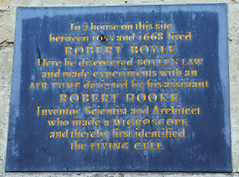Robert Hooke
Robert Hooke
(1635-1703)
scientist, inventor, architect, and 1st identifier of the living cell
assistant of Robert Boyle
Commemorated on 3 plaques
In a house on this site between 1655 and 1668 lived Robert Boyle. Here he discovered Boyle's Law and made experiments with an air pump designed by his assistant Robert Hooke, inventor, scientist and architect who made a microscope and thereby first identified the living cell
Shelley Memorial, University College - High Street, Oxford, United Kingdom where they assisted
Robert Hooke 1635-1703 Eminent Early Scientist first laid to rest here
Great St Helen's, London, United Kingdom where they first laid to rest
The Monument, was designed by Robert Hooke FRS in consultation with Sir Christopher Wren, was built 1671-1677, on the site of St Margaret Fish Street Hill. To commemorate the Great Fire of London 1666. the fire burnt from 2 to 5 September, devastating two-thirds of the city, and destroying 13,200 houses, 87 churches, and 52 Livery Company Halls. The Monument, a freestanding fluted Doric column topped by a flaming copper urn, is 61m/202ft in height, being equal to the distance westward from the site of the bakery in Puddin Lane where the fire first broke out. It's central shaft originally housed lenses for a zenith telescope, and its balcony, reached by an internal spiral staircase of 311 steps, affords panoramic views of the city. The allegorical sculpture on the pedestal above was executed by Caius Gabriel Cibber and shows Charles II coming to assist the slumped figure of the City of London. St Magnus the Martyr Fish Hill Street, ot the south, leads to St Magnus the Martyr, a Wren church, alongside which is the ancient street which led to the medieval London Bridge
Fish Hill Street, London, United Kingdom where they was



